Keeping Your Pets Safe When You Foster

Foster homes help homeless pets by decreasing their stress and limiting their exposure to infectious diseases, which can occur when many animals are housed together (such as in a shelter). Of course, most people who foster pets do so because of their love for animals, and that means they usually have their own pets at home. So how do you keep your own pets safe and healthy when you foster an animal?
Schedule a vet checkup for your pets
First, make sure that your personal pets are in relatively good health (e.g., not currently being treated for a contagious illness) and are up to date on their vaccinations against infectious diseases, such as canine parvovirus and canine distemper (in dogs) or feline panleukopenia, rhinotracheitis, and caliciviruses (in cats).
If you are going to foster a cat long term and your own cats have not been tested for feline leukemia virus (FeLV), this test should be done before you foster. Cats who are FeLV-positive should not share living space with cats who haven’t been vaccinated for FeLV.
To make sure your pets are adequately protected, discuss the status of your pets’ health and current vaccinations with your veterinarian before you bring home a foster animal. In addition, if you have a pet whose immune system is compromised (e.g., the pet is receiving chemotherapy for cancer or steroid therapy for an autoimmune disorder), you might need to take extra precautions or foster a pet at another time.
Separate your pets from foster pets
Ideally, you should keep a foster animal separated from your pets for at least two weeks after arrival in your home. The reason is that most of the common infectious diseases have a three- to 14-day incubation period. So your foster pet could be healthy upon arrival but be incubating a virus that will manifest a few days or weeks later.
However, this two-week separation is not always practical, and it might not always be necessary to separate them for the full period, depending on the age of the animals involved. For example, if you have older animals (say, 5 years and up) who are fully vaccinated and you are fostering a healthy adult animal (over age 2) who has been vaccinated and has been at the shelter for some time, the likelihood of infectious disease transmission is low.
Conversely, if you have young animals at home — especially puppies or kittens under 6 months old — and you are planning to foster animals who have only recently been vaccinated at the shelter or who are ill with or recovering from an infectious disease, then the risk is significantly greater.
To make reasonable decisions regarding risk, it’s very important to work with a veterinarian who understands shelter medicine and infectious disease transmission. Look for a vet who’s a member of the Association of Shelter Veterinarians, or ask your vet to contact a shelter vet if they have questions regarding exposure risks. There is no way to guarantee that your pets will never be exposed, but there is a risk-benefit equation that should be considered before making a decision about fostering.
Reduce risk of disease spread
If you are fostering puppies, we recommend not allowing them to relieve themselves in your yard if the yard’s surface is grass, rock, or dirt. Until puppies are fully vaccinated, they are susceptible to contracting parvovirus, especially if they end up at a shelter, and parvovirus can live in soil for years.
It would be best to have foster puppies go out on your concrete driveway or the sidewalk in front of your house or even on puppy pads in the garage. That way, you can avoid exposing them to anything infectious in the soil in your yard, and you can also prevent contamination of your yard for future foster pets if the dogs who eliminate in the yard are shedding viruses, such as parvo and distemper.
Regarding felines, foster cats should have their own litter pans and bowls. In addition, they should be kept separate from your cats if they are FeLV-positive or if they tend to fight with other cats and are positive for feline immunodeficiency virus (FIV).
Safely introduce animals
After a period of about two weeks, you can begin to introduce your foster animals to your pets. Obviously, you will want to make sure that they get along before allowing them free access to one another.
Cats especially can be quite territorial, so you might need to keep your own cats and a foster cat separate for the duration of the fostering period — not so much for disease control but to prevent territorial fighting if the cats are prone to that behavior.
Because all animals are individuals, it is difficult to provide a one-size-fits-all plan for pet introductions. However, if you’re looking for general tips on how to introduce new pets into your household, check out How to Introduce Dogs to Each Other and How to Introduce Cats to Each Other.
Fostering is not only a vital lifesaving tool, but it’s also something that can bring you much joy and satisfaction as you help to Save Them All. We applaud you for taking this important step.